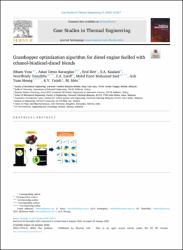Grasshopper optimization algorithm for diesel engine fuelled with ethanol-biodiesel-diesel blends

Göster/
Erişim
info:eu-repo/semantics/openAccesshttp://creativecommons.org/licenses/by/3.0/us/Tarih
2022Yazar
Veza, IbhamKaraoğlan, Aslan Deniz
İleri, Erol
Kaulani, S. A.
Tamaldin, Noreffendy
Latiff, Zulkarnain Abdul
Said, Mohd Farid Muhamad
Üst veri
Tüm öğe kaydını gösterÖzet
A recently invented algorithm known as the grasshopper optimization algorithm (GOA) was employed to optimize diesel engine performance and emission operated with ternary fuel (ethanol-biodiesel-diesel) blends. Using the regression modelling over these experimental results; the mathematical equations between the factors i.e., ethanol ratio (vol%), biodiesel ratio (vol%), engine load (Nm)) and the responses i.e., BSFC (g/kWh), BTE (%), HC (ppm), CO2 (%), NOx (ppm), CO (%) were calculated. Grasshopper optimization algorithm was then run through these regression equations to calculate the optimum factor levels. The confirmation results suggested that the BTE was maximized and the other responses were minimized successfully. For the ANOVA results, under the 95% confidence level with alpha = 5% (=0.05), the p-value for all the regression models was less than 0.05, which indicated the significance of the regression models. In terms of the performance tests of the models, the regression models good fit the given observations with a low prediction error. The grasshopper optimization algorithm showed that ethanol-biodiesel-diesel blend in the ratio of 10%, 7.5%, 82.5% run at 7 Nm engine load gave the optimum results for diesel engine performance and emission characteristics. These findings have important implications for the potential of grasshopper optimization algorithm to improve engine performance and emission characteristics.
Kaynak
Case Studies in Thermal EngineeringCilt
31Koleksiyonlar
Aşağıdaki lisans dosyası bu öğe ile ilişkilidir:


















